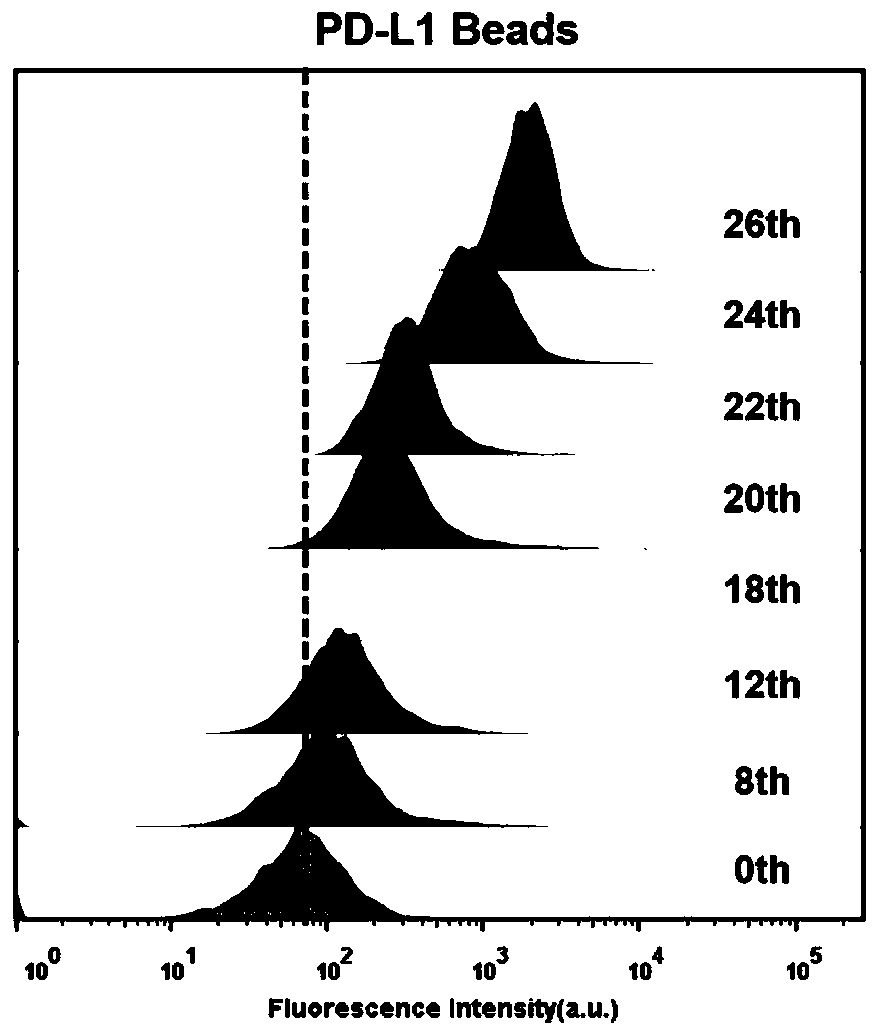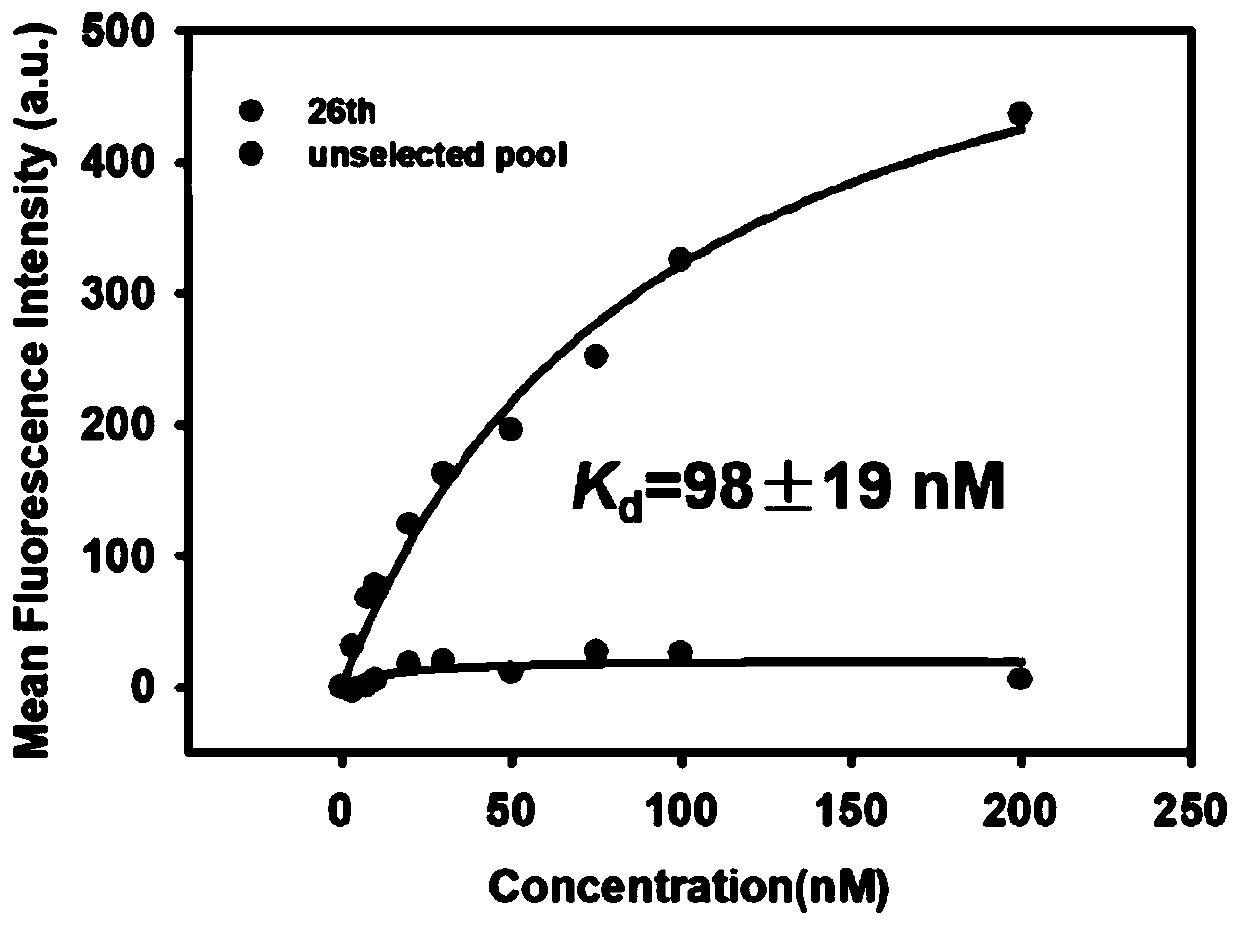Nucleic acid aptamer of programmed death receptor-ligand 1 (PD-L1) and application of nucleic acid aptamer
A technology of programmed death and nucleic acid aptamer, which is applied in the field of molecular recognition tools to detect the expression level of PD-L1, can solve the problems of ununiform pathological evaluation standards, easy inactivation, high cost, etc., and achieve broad application prospects and low synthesis cost , not easy to inactivate the effect
- Summary
- Abstract
- Description
- Claims
- Application Information
AI Technical Summary
Problems solved by technology
Method used
Image
Examples
Embodiment 1
[0067] Example 1 Screening of nucleic acid aptamers for programmed death receptor-ligand 1
[0068] 1) chemically synthesized DNA initial library, as shown in SEQ ID No.8, wherein each DNA strand consists of 80 bases, including fixed sequences of 20 bases at both ends and random sequences of 40 bases in the middle, Specifically: 5'-AGC GTC GAATAC CAC TAC AG-40nt-CTA ATG GAG CTC GTG GTC AG-3', the library capacity is 10 15 above. Take 3nmol DNA initial library dissolved in binding buffer (12mmol / L PBS, pH 7.4, 150mmol / L NaCl, 5mmol / L KCl, 0.55mmol / L MgCl 2 ), perform denaturation treatment: 95°C for 10 minutes, then place on ice for 5 minutes, and finally place at room temperature for 10 minutes;
[0069] 2) Prokaryotic expression of the fusion protein His-PD-L1, through the affinity interaction between His and Ni, the PD-L1 protein was immobilized on Ni agarose microspheres (beads) to obtain PD-L1 protein agarose microspheres PD- L1 beads; incubate the pretreated initial li...
Embodiment 2
[0074] Example 2 Investigating the binding ability of single-stranded DNA enrichment library to PD-L1 protein by flow cytometry
[0075]First, use PCR to amplify the 0, 8, 12, 18, 20, 22, 24, and 26 rounds of DNA enrichment libraries with fluorescent labels, respectively, using the forward primer (SEQ ID No.9): 5'-FAM-AGC GTC GAA TAC CAC TAC AG-3' and reverse primer (SEQ IDNo.10): 5'-Biotin-CTG ACC ACG AGC TCC ATT AG-3', the PCR product has FAM at the 5' end and a band at the 3' end For double-stranded DNA with biotin, add streptavidin agarose microspheres, react at room temperature for 20 minutes, and then use 0.1mol / L NaOH to carry out alkali denaturation and single-strandization, desalt and filter through NAP-5 column, and purify to obtain No. 0, 8, 12, 18, 20, 22, 24, 26 rounds of single-stranded DNA enrichment library;
[0076] Use 200 μl of binding buffer to prepare single-stranded DNA enrichment library solutions for rounds 0, 8, 12, 18, 20, 22, 24, and 26 at a concent...
Embodiment 3
[0078] Example 3 Determination of the dissociation constant between the 26th round single-stranded DNA enrichment library and PD-L1 protein by flow cytometry
[0079] First PCR amplifies the 26th round DNA enrichment library with fluorescent labeling, using the forward primer 5'-FAM-AGC GTCGAA TAC CAC TAC AG-3' (SEQ ID No.9): with the reverse primer (SEQ ID No. .10): 5'-Biotin-CTG ACCACG AGC TCC ATT AG-3', the PCR product is double-stranded DNA with FAM at the 5' end and biotin at the 3' end, add streptavidin agarose micro spheres, reacted at room temperature for 20 minutes, and then used 0.1mol / L NaOH to perform alkali denaturation and single-strandization, desalted and filtered through NAP-5column, and purified to obtain the 26th round of single-stranded DNA enrichment library;
[0080] The dissociation constant (K d ). Use 200 μl of binding buffer to configure the 26th round of single-stranded DNA enrichment library solutions of the above concentrations, and add about 10 ...
PUM
 Login to View More
Login to View More Abstract
Description
Claims
Application Information
 Login to View More
Login to View More - R&D
- Intellectual Property
- Life Sciences
- Materials
- Tech Scout
- Unparalleled Data Quality
- Higher Quality Content
- 60% Fewer Hallucinations
Browse by: Latest US Patents, China's latest patents, Technical Efficacy Thesaurus, Application Domain, Technology Topic, Popular Technical Reports.
© 2025 PatSnap. All rights reserved.Legal|Privacy policy|Modern Slavery Act Transparency Statement|Sitemap|About US| Contact US: help@patsnap.com



